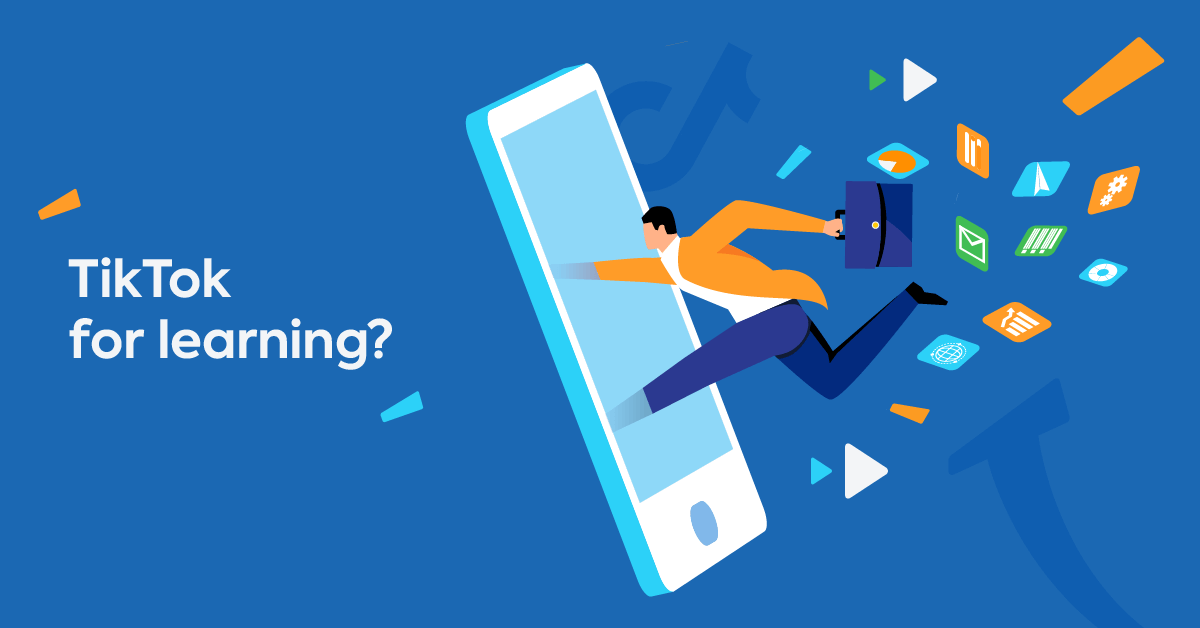We’ve come a long way since the days of “poking” and posting songs on someone’s Facebook wall. From cultivating business contacts in LinkedIn to reading world news on Twitter, social media have become useful tools for both professional and personal development.
But can we actually rely on social media for learning?
TikTok, one of the fastest-growing social media platforms and a Gen-Z favorite, seems to be pondering along the same lines lately. Famous for its fun, unfiltered content, TikTok is currently a marketing Swiss Army knife for brands and creators. Short, fun videos engage audiences and affect the way other social media platforms function.
And now, the short-video sharing app is launching several initiatives tied to learning and education. Enter TikTok for learning.
In this article, we’ll discuss what eLearning with TikTok would look like and whether (and to what extent) we can use it in employee training.
How is TikTok used for learning?
With about half of TikTok users being between 16-24 years old, it sounds like the app could be a great meeting point for learners and educators.
One way to do that is through dedicated hashtags. The hashtag #LearnOnTikTok currently has 63,3 billion views but the content found there varies wildly. For instance, you can find everything from science videos by Bill Nye to advice on “how to beat car dealers”, which makes browsing the hashtag chaotic.
A much more targeted and curated approach is the #EduTok Program. According to the app, the idea of the program is to “democratize learning”, with a focus on their Indian market. There is currently an official TikTok #EduTok account (368.1K followers) that promotes content from TEDtalks and inspirational videos. Working together with Josh Talks and The/Nudge Foundation, TikTok aims to educate 5,000 young individuals through a mentorship program.
TikTok for learning initiatives also include strategic partnerships with educational institutions such as Toppr, Made Easy, and GradeUp. The content created through these partnerships could be an interesting example of how to do eLearning with TikTok. The short and to the point educational videos cover a variety of subjects from myths and facts about COVID-19 to discussing Feynman’s Technique. The focus is again on the Indian market but it’s not difficult to see how it could expand globally.
But does TikTok for learning actually work?
When looking at the educational videos mentioned above, you immediately notice that the “fun” aspects of TikTok (i.e. the use of music and filters) are missing. The need to cram as much information as possible in a few seconds makes it hard to experiment with visual effects.
To maintain engagement and improve the chances of information retention, you need to have charismatic video presenters or SMEs who can play to an audience.
You need someone like Bill Nye — and not every company can afford one.
Build interactive online training courses in minutes with TalentLMS
The learning management system that’s easy to set up, easy to use, and easy to customize.
Why TikTok can’t be used for employee training
Of course, it’s a whole different situation when your goal is not to engage the whole world but just your employees. Training on TikTok could be a fun way for your team to interact with each other as well as with their instructors.
Unfortunately, though, it could also be a great way to get yourself in trouble.
Employee training and development needs to be a well-structured and well-documented process. It’s your responsibility as the training provider to ensure your learning environment is safe, secure, and private.
TikTok is… not that.
Founder/CEO of Digital Barriers Zak Doffman discusses some of TikTok’s cybersecurity issues. One of the most alarming is that if you have your phone number linked to your profile, TikTok can use it to track you online. There have also been many attempts at data breaches on the app that could compromise anything from users’ phone numbers and nicknames, to profile and avatar pictures — even user IDs.
The company itself recognizes they have issues. TikTok recently announced they’re making all accounts that belong to teens (from 13-15 years old) private by default. And if you opt to use TikTok for learning, you have the option to make your account private; accessible only to your employees. But your data won’t be as secure as it should.
Another problem that would further complicate training on TikTok is the app’s non-chronological setup. The videos are algorithmically chosen and you swipe them through vertically. There’s no easy way to see when each video was posted. This could really affect your eLearning efforts, if you’ve created a series of content employees need to consume in a specific order.

How can TikTok inspire eLearning?
Although TikTok for learning may not be what your company needs right now, some of the principles of TikTok could (and should) be implemented into your training strategy. Simply looking at what has made the platform so popular can give you a good sense of the elements you need to apply in your eLearning courses.
Here are some lessons we can take from TikTok:
Video content
The first thing that comes to mind when thinking about using TikTok for learning is video training material. TikTok proved what we already knew: most people, especially in younger age brackets, prefer watching videos to reading when consuming content online.
And although your employee training should contain all types of media, an emphasis on video content will help with engagement.
Up-to-date training content
The biggest success of TikTok is that it offers quantity and speed — if not always quality. Users are bombarded with information and need fresh resources. But that can be hard to achieve in an employee training context, where you need to take time to develop a well-researched and thorough piece of training.
That’s why offering your employees access to a content library like TalentLibrary™ can make all the difference. With a collection of ready-made courses that’s updated often, your users will always find something new and exciting to learn about. For example, and speaking of social media, short, video-based, online marketing training courses could help employees hone their digital marketing skills.
Meet TalentLibrary™
A growing collection of ready-made courses that cover the soft skills
your teams need for success at work
![]()

Microlearning
As using TikTok for learning shows, bite-sized knowledge is where it’s at — especially if your employees are on the younger side. This Training Mag article explains the natural relationship Gen Z has with microlearning and how cutting longer lectures into smaller chunks is nowadays expected.
TikTok videos can’t be longer than 60 seconds — which might be a bit too short for employee training purposes. But even a 3-minute video can help with engagement and information retention.
This way, microlearning can be utilized in all kinds of training, even compliance training.
Gamification
There’s a reason TikTok challenges are so popular. People love games — and they love competing with each other. And yes, this is equally important in the workplace: a recent TalentLMS survey on gamification showed that 83% of those who receive gamified training feel motivated.
Adding elements such as scores, leaderboards, badges, and races in your training will keep employees engaged and promote friendly competition.
Here’s a more detailed guide on how to apply gamification in the workplace.
Peer learning
People learn better when they learn from (and with) each other. And they love sharing their expertise — otherwise, TikTok and all the other platforms would not exist.
To make peer learning part of your training strategy, you need to take stock of your employees’ untapped potential. Allow them to become educators on subjects they may have unique expertise in. Or (virtually) bring in experts from other companies as guest SMEs.
Peer learning is one of the main tenets of an agile learning environment.
Mobile learning
Using social media for learning may have its limitations, but if it has proven one thing is that many current learners prefer learning on their phones. Mobile learning offers flexibility, as learners can complete training on the go — and makes it easier to collaborate with others.
Conclusion
The success of TikTok is closely tied to the characteristics of Gen Z; the first generation born in an internet-connected, mobile world. Gen Z loves fast, authentic, and shareable content that speaks to their values.
These are qualities your employee training should also reflect — even if your current employees are mostly millennials, Gen X, and baby boomers.
After all, Gen Z will be the future of our workforce. Having a learning environment in place that takes their needs into consideration can only be a smart investment.




